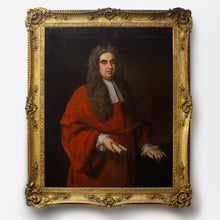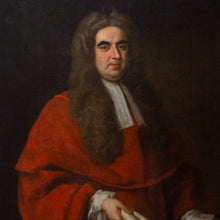This three quarter length portrait by Enoch Seeman (1690-1744) depicts Sir John Baynes, Serjeant-at-Law, and was completed in 1733. The oil on canvas which has recently been fully conserved shows Sir John Baynes in the traditional Serjeant-at-Law red robe and long wig holding a scroll. Dated 1733 the work was produced only three years after Seeman completed what are thought to be ‘coronation portraits’ of King George II and his wife Queen Caroline, circa 1730, which are still held in The Royal Collection. The royal portraits hang separately, with the image of the King residing in St George’s Hall in Windsor Castle, and the image of Queen Caroline hanging at Hampton Court.
Seeman was born in what is now modern day Gdańsk in northern Poland and came to London in the early 18th century to study portraiture like other contemporaries such as Holbein, Lely and Van Dyck. In the earlier part of his career he was referred to as ‘Enoch Seeman junior’ as his father was also a painter, however it could be argued that Seeman junior was the more successful of the two with royal patronage alongside popularity with the nobility and gentry of the period. Seeman is known to have also painted a number of self portraits which are often more expressive than his conservative commissioned works.
Sir John Baynes (1689-1737), was a Serjeant-at-Law and is likely to have commissioned this portrait which Seeman completed and dated in 1733. Perhaps the most notable achievement of Baynes was the building of Palladian mansion ‘Bower House’ in Havering, England, which is thought to have been completed in 1729 under the instruction of notable architect Henry Flitcroft (1697-1769) with remnants from an earlier palace. A plaque on the fireplace in the entrance hall translates to "From the remains of the Royal Palace of Havering Bower, situated on the summit of the hill, this dwelling was founded by John Baynes, Serjeant-at-Law, so that he might retire into sure ease and have pleasure for himself and his friends. The arms of King Edward III sculptured on this stone are sufficient proof of its antiquity. A.D. 1729”. Baynes died in 1737 and was survived by his wife Mary and daughter Lucy. Whilst it is unsubstantiated, it is likely this portrait would have once been housed in the grade I listed Bower House.
The work retains its original gilt wood frame and was fully conserved in 2023.
Measures - 125cm H x 100cm W
Framed size - 153cm H x 128cm W x 11cm D
*PLEASE CONTACT US FOR A SHIPPING QUOTE BEFORE PURCHASING*








